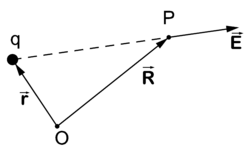Coulomb's law: Difference between revisions
imported>Paul Wormer No edit summary |
imported>Paul Wormer |
||
| Line 32: | Line 32: | ||
The force on a particle of charge −|''Q''| is equal to −'''E'''|''Q''|, that is, the force is antiparallel to the vector '''E'''. The force on a particle with charge |''Q''| is equal to '''E'''|''Q''|, parallel to the '''E'''-vector. | The force on a particle of charge −|''Q''| is equal to −'''E'''|''Q''|, that is, the force is antiparallel to the vector '''E'''. The force on a particle with charge |''Q''| is equal to '''E'''|''Q''|, parallel to the '''E'''-vector. | ||
The experimentally observed additivity of electrostatic forces gives the following electric field at ''P'' when there are ''N'' charges ''q''<sub>''k''</sub> at '''r'''<sub>''k''</sub> | The experimentally observed additivity of electrostatic forces gives the following electric field at ''P'' when there are ''N'' charges ''q''<sub>''k''</sub> at fixed positions '''r'''<sub>''k''</sub>. The electric field is a [[vector field]] | ||
:<math> | :<math> | ||
\vec{\mathbf{E}} = \sum_{k=1}^N \frac{q_k(\vec{\mathbf{R}} - \vec{\mathbf{r}}_k)}{4\pi \epsilon_0\epsilon_r|\vec{\mathbf{R}} - \vec{\mathbf{r}}_k|^3} | \vec{\mathbf{E}}(\vec{\mathbf{R}}) = \sum_{k=1}^N \frac{q_k(\vec{\mathbf{R}} - \vec{\mathbf{r}}_k)}{4\pi \epsilon_0\epsilon_r|\vec{\mathbf{R}} - \vec{\mathbf{r}}_k|^3} | ||
</math> | </math> | ||
depending on <math>\scriptstyle \vec{\mathbf{R}}</math>. The sum stands for a vector sum. | |||
==Derivation from Maxwell's equation== | ==Derivation from Maxwell's equation== | ||
'''(To be continued)''' | '''(To be continued)''' | ||
Revision as of 11:20, 1 February 2008
In physics, Coulomb's law describes the forces acting between electric point charges. The law was first given by Charles-Augustin de Coulomb. It is an inverse-square law for two electric charges very similar to Newton's gravitational law for two masses. An important difference between the two laws is that masses always attract each other, whereas charges may repel or attract. That is, charges may be positive or negative, while masses have the same sign (are always positive by convention).
Formulation
Coulomb discovered experimentally that the force between two small charged bodies separated in air a distance large compared to their dimensions
- varies directly as the magnitude of each charge,
- varies inversely as the square of the distance between them,
- is directed along the line joining the charges,
- is attractive if the bodies are oppositely charged and repulsive if the bodies have the same type of charge.
Further it was shown experimentally that the force is additive, i.e., the force on a test body exerted by a number of charges around it, is the vector sum of the individual two-body forces. Given two charges q and q' a distance r apart, the force F between the particles is,
The quantities ε0 and εr are the vacuum permittivity and the relative static permittivity (also known as relative dielectric constant) of the medium, respectively. The relative dielectric constant of air is: εr = 1.000536 (at ambient temperature and pressure). The formulation of Coulomb's law is in the rationalized SI system of units.
Alternative formulation
The force F divided by Δq on a test particle of charge Δq is the electrostatic field E. The vectpr field E originates from one or more charges acting on the test particle. The charge Δq of the test particle is taken infinitesimally small, that is, it is negligible with respect to the charges causing the field and hence the test particle does not influence the electric field. The direction of the electric field is by convention such that it points away from a positive charge and points toward a negative charge.
Coulomb's law gives the electric field at the point P due to an electrostatic positive point charge q at position . The strength of the electric field depends on the inverse-squared distance of P to q and is directed from q to P, that is,
Note that although this may look like an inverse-cubed dependence, we must not forget that the denominator has dimension length. Indeed, defining a (dimensionless) unit vector by
we see more clearly the inverse-squared dependence on distance:
The force on a particle of charge −|Q| is equal to −E|Q|, that is, the force is antiparallel to the vector E. The force on a particle with charge |Q| is equal to E|Q|, parallel to the E-vector.
The experimentally observed additivity of electrostatic forces gives the following electric field at P when there are N charges qk at fixed positions rk. The electric field is a vector field
depending on . The sum stands for a vector sum.
Derivation from Maxwell's equation
(To be continued)
Reference
J. D. Jackson, Classical Electrodynamics, 2nd edition, John Wiley, New York (1975).








